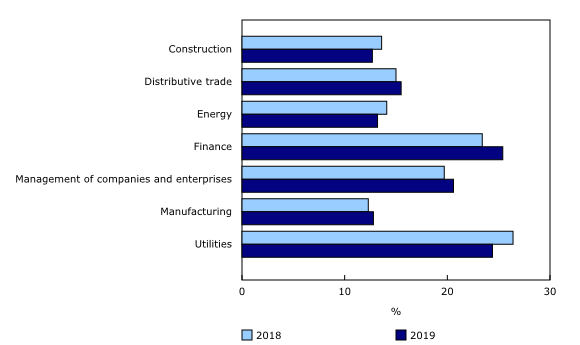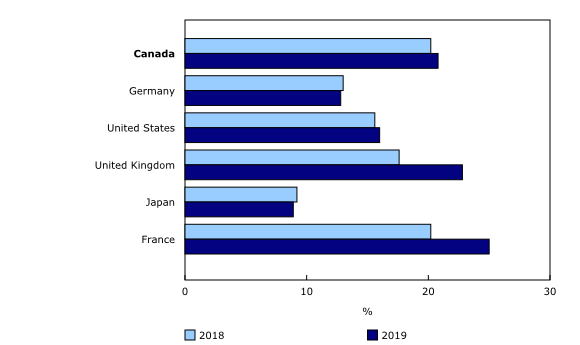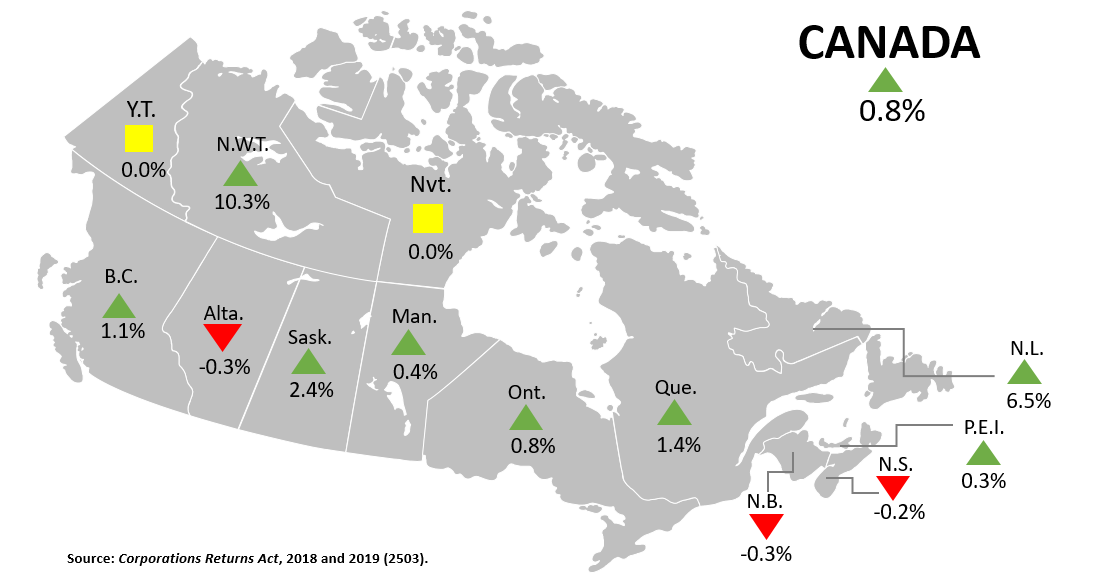Representation of women on boards of directors, 2019
Released: 2022-05-18
Statistics Canada is releasing new data on the gender composition of corporate boards in Canada in 2018 and 2019.
The representation of women on corporate boards of directors has continued to grow since these data were first collected in 2016—a trend also observed by private organizations focusing exclusively on publicly traded corporations. Initiatives implemented to promote gender diversity among board members, such as the requirement for corporations regulated by the Canada Business Corporations Act to disclose the gender of their board members, may have contributed to an increase in the share of women directors. Nevertheless, a recent study published by the Conference Board of Canada suggested that this particular initiative has not accelerated the pace of change for women's representation on boards.
The following release highlights the progress made by women in leadership and strategic decision-making roles working in publicly traded corporations, private corporations and government business enterprises.
Additional information and other studies and statistics related to gender and enterprises can be found in the "Gender, Diversity and Inclusion Statistics Hub", the "Business performance and ownership statistics" portal and in the "Representation of Women on Boards of Directors Visualization Tool".
Share of board seats occupied by women continues to grow
A total of 4,333 seats on boards of directors were occupied by women in 2019, representing 19.2% of all director positions (22,605). The share of women on boards was lower in 2018 (18.4%), with a higher number of women directors (4,848) and a higher total number of directors (26,416). The share of women on boards of directors has increased at an average annual rate of 2.5% every year since 2016.
The dataset contained 7,165 corporations in 2019—a decrease from the 8,697 enterprises recorded in 2018. More board seats were occupied by women who were appointed in both 2018 and 2019 than by women who were newly appointed in 2019 (10.9% of total board seats to 8.2% of total board seats). However, among directors newly appointed in 2019, the share of women was higher (20.5%) than among directors who worked as board member in both years (18.3%).
Almost two-thirds of corporate boards were composed entirely of men directors in these two years (62.3% in 2018 and 60.7% in 2019), although this number has been decreasing at an average rate of 0.9% since 2016. Just over 1 in 10 boards of directors (11.9%) had more than one woman director in 2019, up 5.1% since 2018. Over 1 in 4 boards of directors (27.4%) had one woman director among its members in 2019, an increase of 3.6% since 2018.
Within the boards of directors that were present in the dataset in both 2018 and 2019, board seats held by women decreased slightly, from 18.4% to 18.0%. Conversely, newly recorded corporations in 2019 had a higher share of women directors (21.4%), an increase from 18.0% for corporations that were newly recorded in 2018.
Government business entities continue to have the highest share of women on boards
A higher number of women contributed as directors within government business entities, in which more than one-third of board members were women in 2018 and 2019. This was followed by publicly traded companies, where 25.6% of board members were women in 2018 and 24.4% were women in 2019. The representation of women was lower on the boards of privately held corporations, where less than 1 in 5 directors was a woman in 2018 and 2019.
The proportion of publicly traded corporations with at least one woman director increased by 12.2% from 2018 to 76.7% in 2019. The share of private enterprises with at least one woman director also increased from 2018, at a lesser rate of 3.7%, to 38.5% in 2019. Conversely, the proportion of government business entities with at least one woman on their board decreased by 21.9% to 50.0%. Among government business entities, 44.4% had 30% or more of their board seats occupied by women, and 22.2% had more than 50% of their board seats occupied by women. Just over one-third (34.7%) of publicly traded companies reached a target of at least 30% of board seats occupied by women in 2019 (a decrease of 10.7% from 2018), while over one-quarter of private corporations met this threshold in 2018 (27.5%) and 2019 (29.4%).
Finance and utilities sectors have the largest shares of women on corporate boards
According to a Statistics Canada study, women are more likely to work in the services-producing sector of the economy, while men are more likely to work in the goods-producing sector. This is consistent with the estimates for women on boards of directors—service-related sectors such as finance, utilities, and management of companies and enterprises had a higher concentration of women directors on corporate boards. The finance sector had the highest representation of women directors in 2019 and the most growth from 2018, with women occupying 25.4% of board seats in 2019 (an increase of 8.2% from 2018). The second-highest representation of women directors was in the utilities sector in 2019, with 24.4%, although this sector experienced the greatest decrease from 2018 (-7.5%).
In contrast, the construction and manufacturing sectors recorded the lowest proportions of women in 2019, with less than 13.0% of directors being women in each sector. The share of women directors in the manufacturing sector rose by 4.0% from 2018, while the share of women directors in the construction sector decreased by 6.1%.
Concurrently, almost 4 in 10 corporate boards operating in the utilities sector (39.1%) met a target of at least 30% of director positions held by women in 2019—an increase of 1.8% from 2018. More than one-third of corporations in the finance sector (35.1% in 2018 and 38.8% in 2019) reached this target, while 1 in 5 corporate boards in the manufacturing sector met this target in both years.
Corporations controlled by entities from France and the United Kingdom have the highest shares of women on their boards
In 2019, women were more likely to hold a director seat on boards controlled by entities from France, where 25.0% of board members were women, followed by entities controlled by the United Kingdom (22.8%). The representation of women on boards of directors increased the most from the previous year (+29.9%) in corporations controlled by the United Kingdom, while entities controlled by France reported the second-highest growth (+23.8%). Women were less likely to be represented on the boards of Japanese-controlled corporations, where fewer than 1 in 10 directors were women (9.2% in 2018 and 8.9% in 2019).
Among all of the selected countries of control, gender diversity in corporate boards was highest among government business entities under Canadian control, at 35.3% of seats held by women in 2018 and 35.6% held by women in 2019. Publicly traded corporations controlled by France followed, as women held 28.6% of seats in 2019 (down 21.4% from 2018). The share of women directors grew the most for publicly traded corporations controlled by United Kingdom entities, with an increase of 50.0%, rising from 8.3% in 2018 to 12.5% in 2019.
The largest corporations have the highest representation of women
Assets, which refer to all resources owned by a corporation, are considered a good indicator of a corporation's size. The share of women was highest in the largest corporations—i.e., those in the fourth quartile by asset amount—where almost one-fifth of directors were women (19.9% in 2018 and 20.4% in 2019). The largest corporations tend to have more board members than smaller corporations. Companies in the first quartile (the smallest corporations) had an average of 2.5 members per board in 2019, compared with an average of 4.2 members per board for companies in the fourth quartile. Therefore, corporations in the fourth quartile are more likely to have women as directors. For example, for corporations in the fourth quartile with boards composed of five or more directors, 80.6% had at least one woman member in 2019 (versus 79.5% in 2018), compared with 69.8% of smaller corporations (down from 70.5% in 2018).
The smallest corporations were the least likely to have women directors (17.9% in 2018 and 18.1% in 2019). However, small corporations still had a relatively high share of women directors, which is partly explained by the industry composition of the first quartile. Corporations operating in the finance sector and the management of companies and enterprises sector dominated the first quartile.
Corporations in the second and third quartiles recorded the highest rates of growth in representation of women on boards, with increases of 5.9% in the second quartile and 8.5% in the third.
Share of women on corporate boards up in almost two-thirds of provinces and territories in 2019
The proportion of women directors on boards increased year over year for the majority of provinces and territories in 2019. For example, more than one-third (35.3%) of board seats in the Northwest Territories were occupied by women in 2019, representing an increase of 41.2% compared with the previous year and the highest share of women directors among provinces and territories in 2019.
Newfoundland and Labrador ranked second in both share and growth. In this province, women accounted for 26.1% of board members in 2019, corresponding to annual growth of 33.3%. In this province, more than one-fifth (23.1%) of enterprises operated in the management of companies and enterprises sector—a sector with the third highest representation of women on boards of directors.
It is important to note that the Northwest Territories and Newfoundland and Labrador had a low number of companies. The Northwest Territories accounted for 0.1% of all enterprises in Canada in 2019, while Newfoundland and Labrador accounted for 0.5%. Consequently, a small change in the number of board seats occupied by women can have a large impact on the share of women directors on boards. In comparison, almost half (47.2%) of all enterprises in Canada operated in Ontario in 2019.
Ontario and Quebec, where the majority of Canadians live and where two-thirds of Canadian enterprises are located, experienced slight growth in the share of women directors from 2018 to 2019. Representation rose by 3.9% in Ontario and 7.4% in Quebec. Both provinces saw greater growth since 2016—increases of 5.2% in Ontario and 6.3% in Quebec. In these two provinces, the finance sector was the largest industry, making up 34.9% of enterprises in Ontario and 28.7% of enterprises in Quebec, and had the highest representation of women on boards of directors.
New Brunswick (-2.2%), Alberta (-1.3%) and Nova Scotia (-0.9%) were the only provinces to report decreases in the share of women directors in 2019.
Note to readers
Data sources and methodology
The Corporations Returns Act (CRA) program collects financial and ownership data on corporations conducting business in Canada for public, private and government businesses. Corporations are included in the sample if their gross revenues for a fiscal period exceed $200 million, their assets exceed $600 million or their long-term debt or equity owing to non-residents exceeds a book value of $1 million.
However, while these data are used to understand the domestic and foreign residence of corporate board members, they cannot provide information on the gender profile of these individuals.
To identify the gender of these corporate board members, a two-step process was undertaken.
First, the data were integrated, where possible, with gender data from the Derived Record Depository—a national dynamic relational database containing only the basic personal identifiers of Canadians and built by integrating information from administrative data files available at Statistics Canada, including the T1 Personal Master file, for the purpose of facilitating the integration of data from other files.
Then, for the records that could not be integrated, probabilistic imputation was employed using information available about the corporate board members.
The data obtained through the CRA program are used to evaluate the extent of foreign control in the Canadian economy and are summarized in an annual report to Parliament. To release information from the CRA program, Statistics Canada must receive approval from Parliament.
The corporations targeted by the CRA represent a subsample of the total population of incorporated enterprises operating in Canada, which are included in the Annual Financial and Taxation Statistics for Enterprises (AFTS). The CRA publishes statistical estimates at the legal entity level, while the AFTS disseminate statistical estimates at the enterprise level. Because the AFTS assets are consolidated, there is an overrepresentation of assets in the CRA when compared with the assets in the AFTS.
Due to changes and improvements in the Corporations Returns Act data collection process, the 2019 dataset was smaller than prior years (22,605 directors, compared to 26,416 in 2018).
Definitions
Directors (members) are responsible for supervising the activities of the corporation and for making decision regarding those activities. In the context of this release, "directors" and "members" refer to the same thing.
The board of directors is the governing body of a corporation.
Table
The data table used for this analysis is available today (Table 33-10-0501-01 – Representation of women and men on boards of directors, by gender and by firm's attribute).
Visualization tool
The "Representation of Women on Boards of Directors Visualization Tool" is a comprehensive analytical tool that presents annual changes to the representation of women and men on boards of directors in Canada.
Revision policy
Statistical revisions are carried out annually to incorporate the most current information available. Generally, these revisions are limited to the previous reference year.
Periodically, comprehensive revisions could be conducted, which would generally entail revisions beyond the scope of the standard revision window. These provide an opportunity to enhance estimation methods and incorporate improved data sources and concepts.
Sources of revisions
The revisions to data for reference year 2019 came primarily from an update of the 2019 dataset and from methodological enhancements. These revisions are described below. As a result of these revisions, new benchmark information is available with the use of additional sources, notably, the use of tax data information to ensure that most of the units met the inclusion criteria of the Corporations Returns Act. Furthermore, the units that were inactive within the reference year based on the administrative data files and that reported tax revenues lower than $30,000 were removed.
Impact of the revisions
Data on the gender of board directors for reference year 2018 were revised from 28,071 directors to 26,416. The proportion of women board directors for the reference year 2018 was revised up to 18.4% from 18.3%. The growth rate of director seats held by women also increased, to 2.8% from 2.2%.
Requirement to disclose
Under the Canada Business Corporations Act, publicly traded corporations are required to disclose information on the number of women on their boards, and their diversity policies, targets and statistics in relation to the four employment equity groups for boards of directors and executive officer positions. Essentially, while it will not be mandatory for public corporations to adopt diversity policies or quotas, they will also be required to disclose whether they did so or not and—if not—to explain why.
Contact information
For more information, or to enquire about the concepts, methods or data quality of this release, contact us (toll-free 1-800-263-1136; 514-283-8300; infostats@statcan.gc.ca) or Media Relations (statcan.mediahotline-ligneinfomedias.statcan@statcan.gc.ca).
- Date modified:






